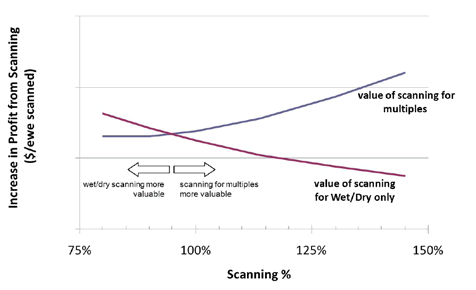|
Pregnancy Scanning is used to identify multiple pregnancies to better manage twin bearing ewes
and to identify and remove barren ewes. Careful consideration needs to be made of the costs and
benefits of pregnancy scanning to achieve a management and economic gain in the breeding ewe
enterprise. Skilled contractors can also scan ewes to age the foetuses conceived in either in the
first or second cycle of joining. This information can be used to separate mobs into early and late
lambing flocks and better allocate feed and limit the number of ewes in twinning mobs.
The benefit from determining pregnancy status relies on the proportion of drys, singles and
twins in the mob. As the scanning rate (foetuses/100 ewes) increases, the benefit of scanning for
multiples increases compared to the benefit of scanning for just wet/dry. Above 90% scanning
(90 foetuses/100 ewes joined) the value of scanning for multiples becomes higher than the
benefit for scanning on wet/dry alone. Figure 1 shows the benefit when the impact of culling dry
ewes on the overall flock structure is accounted for.
Figure 1. Pregnancy scanning value per ewe
(accounting for impacts of cullling on flock structure)

Reallocation of feed to twin-bearing ewes:
Scanning for multiples allows the twinning ewes to be managed separately. Twin-bearing ewes
need to be 0.3 of a Condition Score better than single-bearing ewes at lambing to ensure good
birth weights and survival and optimise the lifetime production of their lambs. In average
seasons it is most profitable to reduce feed for the dry ewes and give more to the twin-bearing
ewes. In poor seasons it is more profitable to reduce feed for the dry and single- bearing ewes and
give more to the twin-bearing ewes.
Dealing with dry ewes:
Identifying the dry ewes can add value to the ewe flock through managing them differently, ie.
selling them or giving them less feed and running them as a wool producing flock only. Dry ewes
cost less to run as they can be run as a wether flock, producing a good fleece on 7 MJ energy/
day. Leaving the non-pregnant ewes in the lambing flock costs money as they will eat as much as
pregnant ewes for little additional benefit and they will compete with pregnant ewes when feed is
limiting.
|